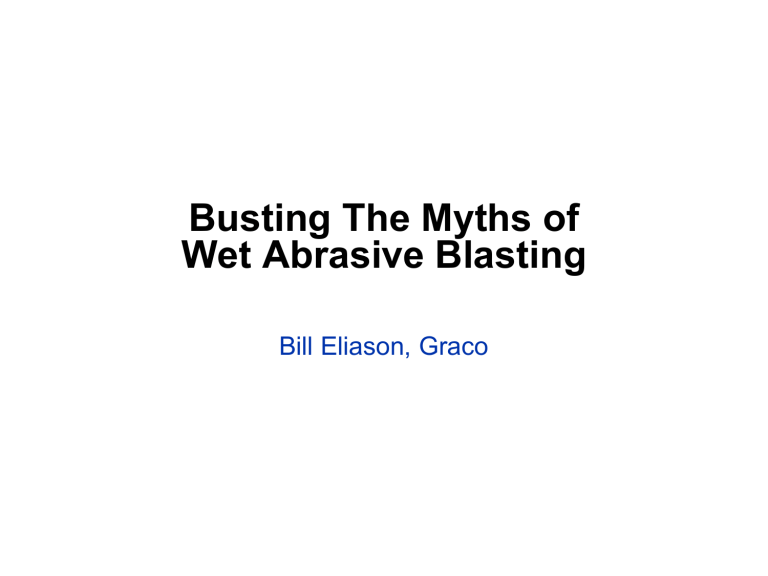
Busting The Myths of Wet Abrasive Blasting Bill Eliason, Graco Origins of Wet/ Vapor Abrasive Blasting • Wet Abrasive Blasting was first introduced to counter the dust created by dry blasting. • Water usage in blasting was first tried in 1941 • Process was never perfected • Negative perceptions exist What Is Wet Abrasive Blasting? – Water is mixed with abrasive and air and propelled by air pressure What Is Wet Abrasive Blasting? – Abrasive is suspended in a water projected at high velocity by a forceful flow of compressed air Problems With Wet Blasting • Each wet system… although eliminating dust has had many drawbacks and problems • Over time these drawbacks and problems from older wet blast technologies have lead to many myths about anything wet abrasive Improving Wet / Vapor Blasting • New developments in Wet and Vapor Abrasive Blast technologies – Increased production rates to decreased water consumption – Optimized air, water and media ratio for optimal performance – Able to achieve same profile compared to traditional blasting methods – Mixes water with media inside the pot • Adds weight to each particle (weight X speed = momentum) • Reduces friction which causes production to remain high • Makes the transportation of the media more efficient because of the lubrication factor Busting or Confirming the Myths • Myth # 1 – The New Wet and/or Vapor Abrasive Blast Technology isn’t as fast as Dry Blasting • Fact – These new technologies are comparable to dry abrasive productions rates, and in some cases even faster Myth Busting: Not as fast Myth Busting: Not as fast • That was over 40 mils (1.016 mm) of a thick lining at a waste treatment plant – in real time. • When timed and compared to dry blasting on this job vapor abrasive blasting was 3 x faster Myth Busting: Wet and Messy • Myth # 2 – The New Wet and/or Vapor Abrasive Blast Technology is too Wet and Messy • Fact – The new Vapor Abrasive Blast technology is using far less water than older systems • Uses 10 to 12 gallons an hour with 80 grit garnet Myth Busting: Wet and Messy Myth Busting: Won’t Meet Specs • Myth # 3 – Using the New Wet and/or Vapor Abrasive Blast Technology won’t meet SSPC SP10 specification for near white metal • Fact – Does meet spec according to Joint Surface Preparation Standard NACE No. 2/SSPC-SP 10 Near-White Metal Blast Cleaning – Section 5: Blast Cleaning Methods and Operation – Sub Section 5.3 Myth Busting: Won’t Meet Specs • Other methods of surface preparation (such as wet abrasive blast cleaning) may be used to achieve a near-white metal blast cleaned surface by mutual agreement between those responsible for establishing the requirements and those responsible for performing the work. Information on the use of inhibitors to prevent the formation of rust immediately after wet abrasive blast cleaning is in Paragraph A5 Breaking The Myths • Myth # 4 – The New Wet and/or Vapor Abrasive Blast Technology won’t cut/remove hard coatings and linings or pitted rust • Fact – Far more efficient at cutting hard coatings and linings as well as mill scale and pitted rust because of the way water and or vapor is utilized in the system. Breaking The Myths Myth Busting: Steel Profile • Myth # 5 – The New Wet and/or Vapor Abrasive Blast Technology can’t achieve a deep profile on steel substrates • Fact – These new wet technologies can achieve a full range of profiles on carbon steel from .5 to 6.5 based on grit size and hardness Myth Busting: Steel Profile • Additional advantages from Vapor and Wet Blast technologies regarding profiles – The profile has more peaks and valleys per cubic ft. creating better coating adhesion – This is possible because the technology uses smaller grit sizes due to the additional weight (mass) added from water… creating the same effect as if it was larger grit Myth Busting: Steel Profile • Dry Blast Systems use 16~20 grit to achieve deep profiles – 16 grit averages 0.043 inches (1.1mm) – 20 grit averages 0.037 inches (0.94mm) • Wet Abrasive Systems use 80~100 grit for a good profile – 80 grit averages 0.0065 inches (0.17mm) – 100 grit averages 0.0048 inches (0.12mm) • 100 grit is about 1/9 the size of 16 grit Myth Busting: Steel Profile • 9x more peaks and valleys in the same area compared to dry blasting!! • Giving greater coating or lining surface adhesion Understanding the Power of Water 20 Why It Works • Momentum = Mass x Velocity • Water weighs 8.33 lbs. / gallon • By encapsulating each particle, you are adding from 60 to 120 lbs. to the weight of the media per hour. – Conventional blasters only have the weight of the media. Therefore, they try to blast with larger particles in order to blast more aggressively. • Water assists flow of media through the blast hose, thereby reducing any loss of speed caused by friction (drag). This keeps the momentum factor high. • Water acts to reduce splash-back by trapping the dust caused by both the media and the coating being removed. 21 Water Encapsulated Media • Due to water’s surface tension, the media is encapsulated, which adds weight and “lubricates” each particle. • The added weight increases momentum. The lubrication is one of the reasons why EQ’s hoses and nozzles last 3 to 5 times longer than dry-blasting hoses and nozzles. 22 Media and Water at Point of Impact • When the encapsulated particle hits the surface, the “water-jacket” is shed. • This action traps any dust created by the media and the removed surface material. 23 The Hydraulic Effect • The inertia of the water drives the droplet into the impact area, and the force of the particle hitting the area is made far more effective by this hydraulic reaction. • Water cannot be compressed and will erupt out of the impact area, causing additional removal of the coating being blasted. 24 The “Feathered” Impact Zone • The hydraulic reaction greatly improves efficiency (less media and time required to do the same job). • This aids in producing a “feathered” edge with the desired profile to meet many different types of applications. 25 Questions? 26

